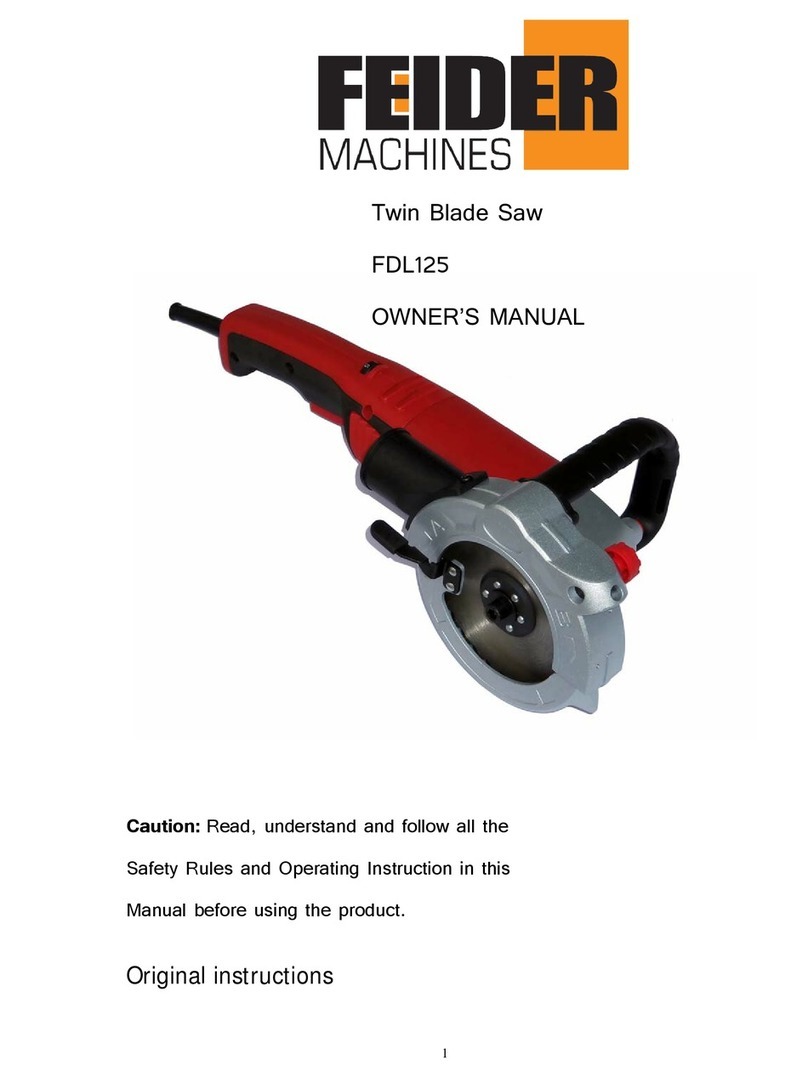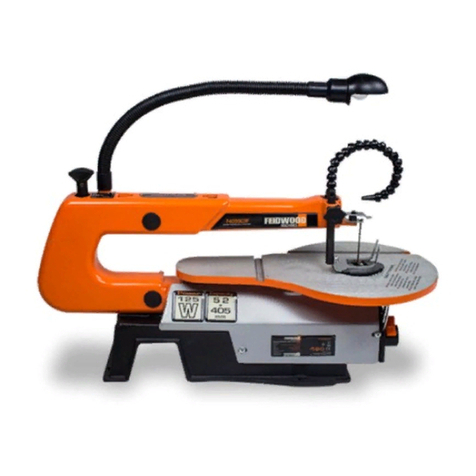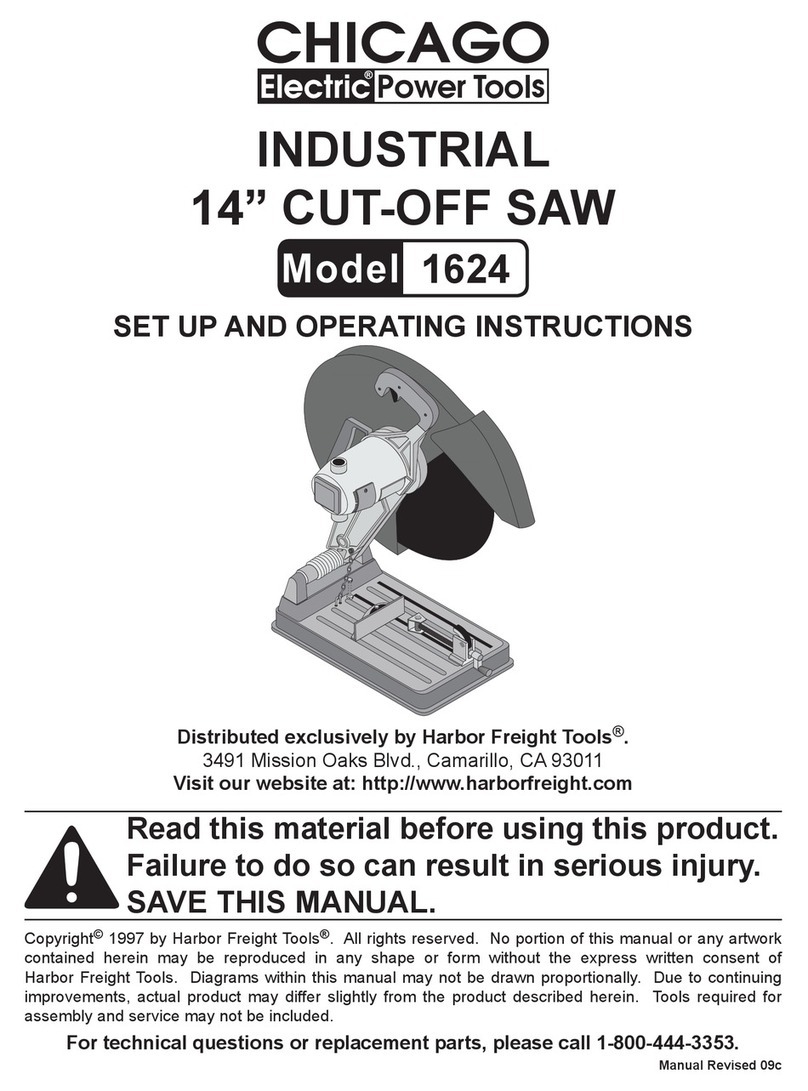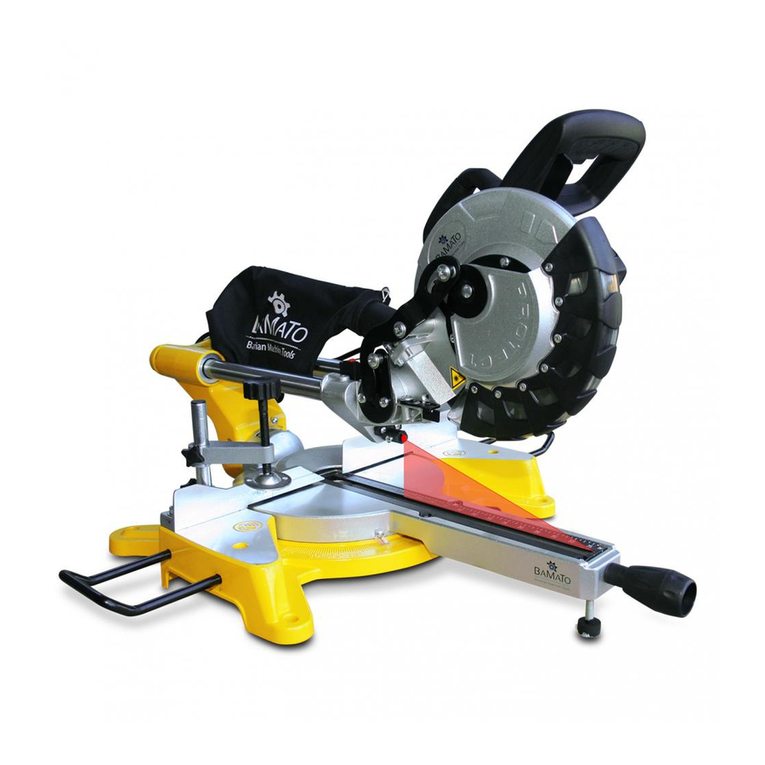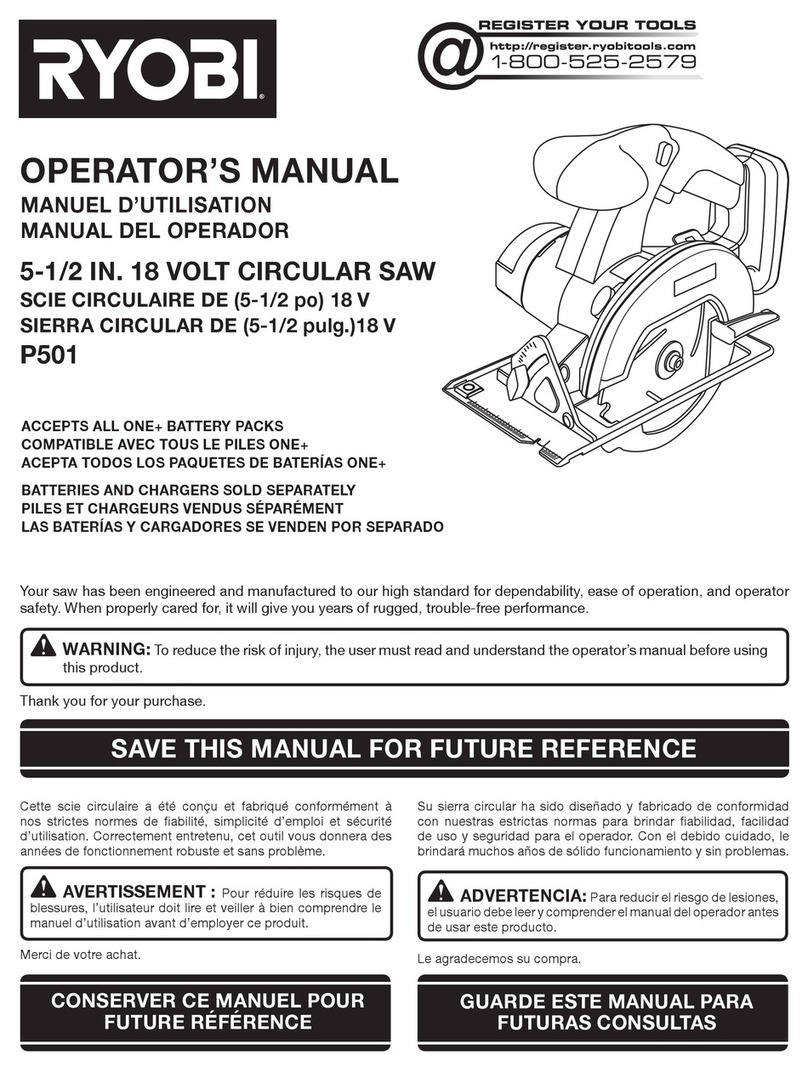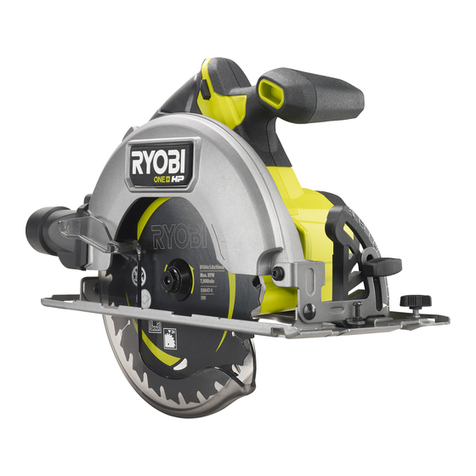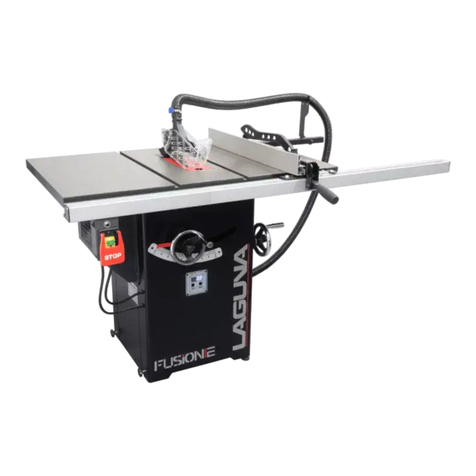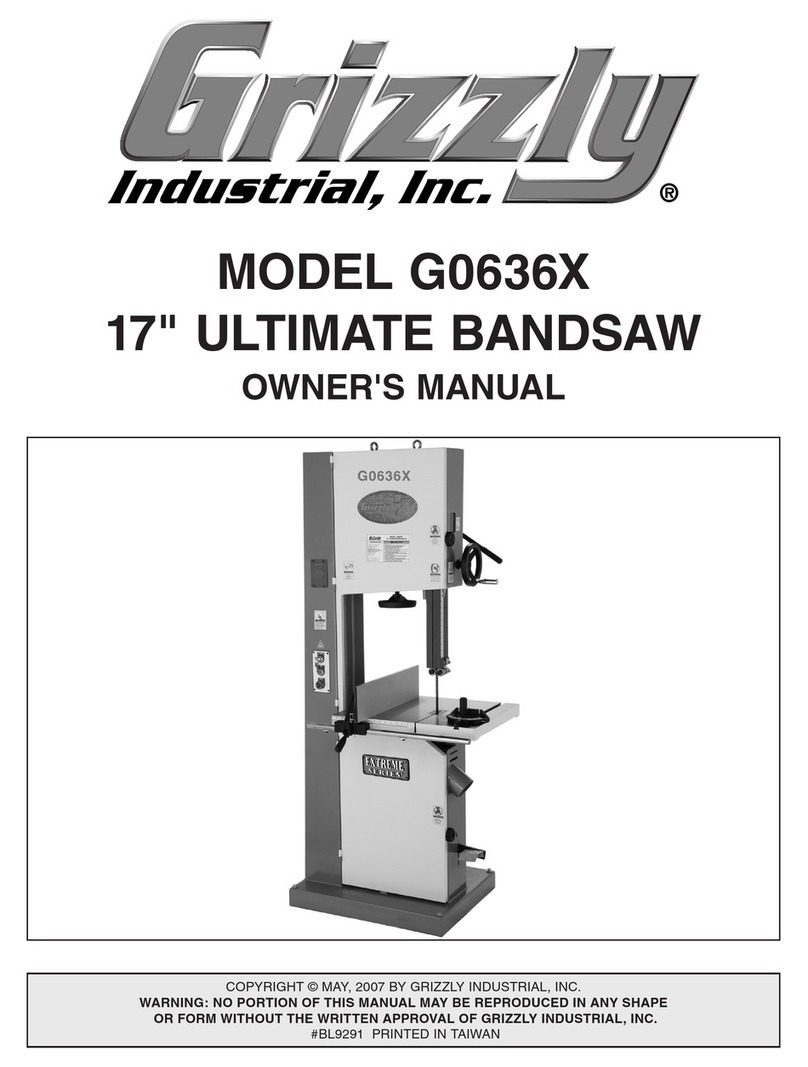Feider Machines FSSAB20V-B User manual

ORIGINAL INSTRUCTIONS >EN
CORDLESS RECIPROCATING SAW
FSSAB20V-B
USER GUIDE
CAUTION: Read this manual before using this machine!

CONTENTS
1. INTENDED USE 3
2. SAFETY INSTRUCTIONS 3
3. YOUR PRODUCT 7
4. OPERATION 8
5. CLEANING AND MAINTENANCE 11
6. DISPOSAL 12
7. DECLARATION OF CONFORMITY 12
8. WARRANTY 13
9. PRODUCT FAILURE 14
10. WARRANTY EXCLUSIONS 15

1. INTENDED USE
This saw intended to be used for cutting wood with the provided blade; that includes plywood, panelling, composition
board and hardwood.
Use this blade only for cutting wood. Cutting others material can create accidents and injuries.
Others type of blades can be used in this machine, such as blades for cutting drywall, plastics, metals, etc. You can
purchase them in specialized stores. Use only accessories of same trademark and recommended. Ask advice to your
retailer.
Do not use this tool for others purposes.
2. SAFETY WARNINGS
2.1 GENERAL POWER TOOL SAFETY WARNINGS
WARNING Read all safety warnings and all instructions. Failure to follow the warnings and instructions may
result in electric shock, fire and/or serious injury.
Save all warnings and instructions for future reference. The term "power tool" in the warnings refers to your
mains-operated (corded) power tool or battery-operated (cordless) power tool.
1) Work area safety
a) Keep work area clean and well lit. Cluttered or dark areas invite accidents.
b) Do not operate power tools in explosive atmospheres, such as in the presence of flammable liquids, gases
or dust. Power tools create sparks which may ignite the dust or fumes.
c) Keep children and bystanders away while operating a power tool. Distractions can cause you to lose control.
2) Electrical safety
a) Power tool plugs must match the outlet. Never modify the plug in any way. Do not use any adapter plugs
with earthed (grounded) power tools. Unmodified plugs and matching outlets will reduce risk of electric shock.
b) Avoid body contact with earthed or grounded surfaces, such as pipes, radiators, ranges and refrigerators.
There is an increased risk of electric shock if your body is earthed or grounded.
c) Do not expose power tools to rain or wet conditions. Water entering a power tool will increase the risk of
electric shock.
d) Do not abuse the cord. Never use the cord for carrying, pulling or unplugging the power tool. Keep cord
away from heat, oil, sharp edges or moving parts. Damaged or entangled cords increase the risk of electric shock.
e) When operating a power tool outdoors, use an extension cord suitable for outdoor use. Use of a cord
suitable for outdoor use reduces the risk of electric shock.
f) If operating a power tool in a damp location is unavoidable, use a residual current device (RCD) protected
supply. Use of an RCD reduces the risk of electric shock.
3) Personal safety
a) Stay alert, watch what you are doing and use common sense when operating a power tool. Do not use a
power tool while you are tired or under the influence of drugs, alcohol or medication. A moment of inattention
while operating power tools may result in serious personal injury.
b) Use personal protective equipment. Always wear eye protection. Protective equipment such as dust mask,
non-skid safety shoes, hard hat, or hearing protection used for appropriate conditions will reduce personal injuries.
c) Prevent unintentional starting. Ensure the switch is in the off-position connecting to power source and/or
battery pack, picking up or carrying the tool. Carrying power tools with your finger on the switch or energizing
power tools that have the switch on invites accidents.
3

d) Remove any adjusting key or wrench before turning the power tool on. A wrench or a key left attached to a
rotating part of the power tool may result in personal injury.
e) Do not overreach. Keep proper footing and balance at all times. This enables better control of the power tool in
unexpected situations.
f) Dress properly. Do not wear loose clothing or jewellery. Keep your hair, clothing and gloves away from
moving parts. Loose clothes, jewellery or long hair can be caught in moving parts.
g) If devices are provided for the connection of dust extraction and collection facilities, ensure these are
connected and properly used. Use of dust collection can reduce dust-related hazards.
h) Do not let familiarity gained from frequent use of tools allow you to become complacent and ignore tool
safety principles. A careless action can cause severe injury within a fraction of a second.
4) Power tool use and care
a) Do not force the power tool. Use the correct power tool for your application. The correct power tool will do the
job better and safer at the rate for which it was designed.
b) Do not use the power tool if the switch does not turn it on and off. Any power tool that cannot be controlled
with the switch is dangerous and must be repaired.
c) Disconnect the plug from the power source and/or the battery pack from the power tool before making any
adjustments, changing accessories, or storing power tools. Such preventive safety measures reduce the risk of
starting the power tool accidentally.
d) Store idle power tools out of the reach of children and do not allow persons unfamiliar with the power tool
or these instructions to operate the power tool. Power tools are dangerous in the hands of untrained users.
e) Maintain power tools. Check for misalignment or binding of moving parts, breakage of parts and any other
condition that may affect the power tool’s operation. If damaged, have the power tool repaired before use.
Many accidents are caused by poorly maintained power tools.
f) Keep cutting tools sharp and clean. Properly maintained cutting tools with sharp cutting edges are less likely to
bind and are easier to control.
g) Use the power tool, accessories and tool bits etc. in accordance with these instructions, taking into
account the working conditions and the work to be performed. Use of the power tool for operations different from
those intended could result in a hazardous situation.
h) Keep handles and grasping surfaces dry, clean and free from oil and grease. Slippery handles and grasping
surfaces do not allow for safe handling and control of the tool in unexpected situations.
5) Battery tool use and care
a) Recharge only with the charger specified by the manufacturer. A charger that is suitable for one type of battery
pack may create a risk of fire when used with another battery pack.
b) Use power tools only with specifically designated battery packs. Use of any other battery packs may create a
risk of injury and fire.
c) When battery pack is not in use, keep it away from other metal objects, like paper clips, coins, keys, nails,
screws or other small metal objects, that can make a connection from one terminal to another. Shorting the
battery terminals together may cause burns or a fire.
d) Under abusive conditions, liquid may be ejected from the battery; avoid contact. If contact accidentally
occurs, flush with water. If liquid contacts eyes, additionally seek medical help. Liquid ejected from the battery
may cause irritation or burns.
e) Do not use a battery pack or tool that is damaged or modified. Damaged or modified batteries may exhibit
unpredictable behaviour resulting in fire, explosion or risk of injury.
f) Do not expose a battery pack or tool to fire or excessive temperature. Exposure to fire or temperature above
130 °C may cause explosion.
NOTE The temperature „130 °C“ can be replaced by the temperature „265 °F“.
4

g) Follow all charging instructions and do not charge the battery pack or tool outside the temperature range
specified in the instructions. Charging improperly or at temperatures outside the specified range may damage the
battery and increase the risk of fire.
6) Service
a) Have your power tool serviced by a qualified repair person using only identical replacement parts. This will
ensure that the safety of the power tool is maintained
b) Never service damaged battery packs. Service of battery packs should only be performed by the manufacturer or
authorized service providers.
2.2 SAFETY INSTRUCTIONS FOR RECIPROCATING SAWS
c) Hold the power tool by insulated gripping surfaces, when performing an operation where the cutting
accessory may contact hidden wiring. Cutting accessory contacting a "live" wire may make exposed metal parts of
the power tool "live" and could give the operator an electric shock.
d) Use clamps or another practical way to secure and support the workpiece to a stable platform. Holding the
workpiece by hand or against your body leaves it unstable and may lead to loss of control.
2.3 SPECIFIC SAFETY RULES
- Do not stare at the tool with the blade touching any surface. The blade action will bounce the tool and may
cause bodily injury.
- Allow the tool to come to a complete stop before putting it down. A running tool will jerk when the blade tip
contacts any surface.
- Always wear safety glasses or goggles, normal prescription eye or sunglasses are not safety glasses.
- Do not cut oversized work pieces.
- Do not cut nails or screws unless you are using a blade specifically designed for this purpose. Inspect your
material before cutting.
- Before switching on the tool, be sure that the blade is not contacting the work piece.
- Keep hands away from moving parts and on the top surface of the work piece. Do not place hands below work
surface while saw is operating.
- Check your area for proper clearance before cutting. This will avoid cutting into your workbench, the floor, etc.
2.4 RESIDUAL RISKS
Even with use of the tool as described, it is impossible to eliminate all residual risk factors. The following hazards
may be present in connection with the construction and design of the tool:
- Pulmonary lesions if an effective mask is not worn.
- Hearing damage if effective hearing protection is not worn.
- Body injuries caused by vibration emissions if the electrical appliance is used improperly or for a prolonged
or poorly maintained period.
2.5 SAFETY INSTRUCTIONS FOR BATTERIES AND CHARGER
Batteries
Never attempt to open for any reason.
Do not store in locations where the temperature may exceed 40°C (104°F).
Charge only at ambient temperatures between 4°C and 40°C(39.2°F and 104°F).
5

Charge only using the charger provided with the tool.
Store your batteries in a cool dry place (5°C-20°C/41°F-68°F). Never store batteries in discharged state.
It is better for Li-ion batteries to discharge and reload them regularly (at least 4 times a year). The ideal
charge for long-term storage of your Li-ion battery is 40% of capacity.
When disposing of batteries, follow the instructions given in the section “Protecting the environment”.
Do not cause short circuits. If connection is made between the positive (+) and negative (-) terminal directly
or via accidental contact with metallic objects, the battery is short circuited and an intense current will flow
causing heat generation which may lead to casing rupture or fire.
Do not heat. If batteries are heated to above 100°C (212°F), sealing and insulating separators and other
polymer components may be damaged resulting in electrolyte leakage and/or internal short circuiting
leading to heat generation causing rupture or file. Moreover do not dispose of the batteries in fire, explosion
and/or intense burning may result.
Under extreme conditions, battery leakage may occur. When you notice liquid on the battery, proceed as
follows:
Carefully wipe the liquid off using a cloth. Avoid skin contact.
In case of skin or eye contact, follow the instructions below:
•Immediately rinse with water. Neutralize with a mild acid such as lemon juice or vinegar.
•In case of eye contact, rinse abundantly with clean water for at least 10 minutes. Consult a
physician.
Fire hazard! Avoid short-circuiting the contacts of a detached battery. Do not incinerate the
battery.
Charger Charger
Only use the model of charger recommended. See
the technical data".
2.6 EXPLANATION OF SYMBOLS
Conforms to relevant safety standards
To reduce the risk of injury, the user must read and understand this manual before using this product.
Wear ear protectors. Exposure to noise can cause hearing loss.
Wear eye protection.
Wear respiratory protection.
Do not dispose of old appliances with domestic rubbish
6

3. YOUR PRODUCT
a. Description
1. Saw blade
2. Soleplate
3. Led light
4. ON/OFF switch
5. Lock-off button for ON/OFF switch
6. Battery platform
7. Blade clamp and release mechanism
b. Technical data
Tension
20V d.c.
No load speed
0-2800/min
Blade stroke
22mm
Cutting capacity
65mm in wood / 6 mm in metal
Battery type
Recommendation of battery to use:
Model: FBA20U2 or FBA20U4
20V d.c. 2Ah or 4Ah
Charger type
Recommendation of charger to use:
Model: FFC20EU
Input 220-240V~ 50-60Hz, 65W max; Output 21V d.c., 2.5A
Sound power level
LwA: 92.93dB(A) K=5dB(A)
Sound pressure level
LpA: 81.93dB(A) K=5dB(A)
Vibration
Cutting board mode:
- Front handle: 14 m/s²
- Rear handle: 12,3 m/s²
Cutting wooden beams mode
- Front handle: 10,5 m/s²
- Rear handle: 16,8 m/s²
K= 1,5m/s²
Information:
The declared vibration total value has been measured in accordance with a standard test method and may be
used for comparing one tool with another;
The declared vibration total value may also be used in a preliminary assessment of exposure.
Warning:
that the vibration emission during actual use of the power tool can differ from the declared total value depending
on the ways in which the tool is used;
1
2
3
4
5
6
7
7

Need to identify safety measures to protect the operator that are based on an estimation of exposure in the actual
conditions of use (taking account of all parts of the operating cycle such as the times when the tool is switched off
and when it is running idle in addition to the trigger time).
Wear hearing protection.
4. OPERATION
4.1 CHARGING THE BATTERY PACK
NOTE: The battery and charger not delivered in package, you can buy Buider battery platform 1
which used for full range.
1). Take the battery pack out of the equipment. Do this by pressing the side pushlock buttons.
2). Check that your mains voltage is the same as that marked on the rating plate of the battery charger.
Insert the power plug of the charger into the socket outlet. The RED LED will then begin to light.
3). Insert the battery pack into the battery charger .then the red LED on charger will begin to Green flash
light.
4). You will find a label with “Charger indicator” of the LED indicator on the charger.
The battery pack can become a little warm during the charging. This is normal.
If the battery pack fails to charge, check:
Voltage at the power socket
Whether there is good contact at the charging contacts.
Whether the battery pack is warm or not, The battery protection system will not allow the battery to be
charged if the battery temperature is over 40℃after use, allow the battery pack to cool to room
temperature before commencing with the charging.
If the battery pack still fails to charge, send the charging unit and the battery pack to our customer service
center.
To ensure that the battery pack provides long service, you should take care to recharge it promptly. You
must recharge the battery pack when you notice that the power of the cordless vacuum drops. Never allow
the battery pack to become fully discharged. This will cause it to develop a defect.
Battery capacity indicator
Press the switch for the battery capacity indicator . The battery capacity indicator shows the charge status
of the battery using 4 LEDs as following:
All 4 LEDs are lit:
The battery is fully charged.
3 LED(s) are lit:
The battery has approx 75% remaining charge.
2 LED(s) are lit:
The battery has approx 50% remaining charge.
1 LED is lit:
The battery will be empty soon, please recharge the battery.
4.2 CHARGER INDICATOR
Indicator status
Explanations and actions
Ready for use
The charger is connected to the mains and is ready for use; there is no battery pack
in the charger.
8

Charging
The charger is charging the battery pack in charge mode.
Battery pack is full of charge.
Charging is finished and battery pack in the charger.
The temperature of battery is too high or too low, the charger is under protection
status. The charging function can be recovered after the temperature is normal.
Unrecoverable battery malfunction.
4.3 INSERTING AND REMOVING THE BATTERY
WARNING: Before making any adjustments ensure the drill is switched off with the
direction of rotation selector in the center position
1. Remove the battery: press the battery release latch in and at the same time pull the battery pack off.
2. To insert the battery, push the battery pack onto the contacts of the tool.
FIG.1
Warning! Always remove the battery from the tool when assembling accessories, making adjustments,
during transport or when the tool is not in use. Remove the battery will prevent accidental starting which
could cause severe personal injury.
NOTE: To avoid serious personal injury, always remove the battery and keep your hands away from the
lock button while transporting the tool.
4.4 INSTALL / REMOVE THE SAW BLADE
The product is provided with a blade, intended to be used for cutting wood. That includes plywood,
panelling, composition board and hardwood.
Use this blade only for cutting wood. Cutting others material can create accidents and injuries.
Others type of blades can be used in this machine, such as blades for cutting drywall, plastics, metals,
etc. You can purchase them in specialized stores. Use only accessories of same trademark and
recommended. Ask advice to your retailer.
a) Turn the quick-release blade clamp (6) anticlockwise and insert the saw blade, then release the quick-release blade
clamp(6). Make sure that the saw blade issecurely fastened. (Fig. 2)
b) Turn the quick-release blade clamp (6) anticlockwise to remove the saw blade.(Fig. 3)
9

NOTE: The blade must be inserted with the teeth tuned downwards, the side with the hole must inserted in
the spindle. Failure to install the balde will cause damage, accidents and injuries.
4.5 SOLEPLATE ASSEMBLY ADJUSTMENT
a) Loosen the two cap screws at the bottom of the front handle with the hex key provided.(Fig. 4)
b) Move the pivot shoe (2) in or out to the position required.
c) Tighten both cap screws.
4.6 STARTING AND STOPPING
a. The reciprocating saw is equipped with a lock button (3) which reduces the possibility of accidental starting. The
lock button (3) is located on the handle above the on/off switch trigger. You must depress the lock button in order
to pull the switch trigger. The lock button resets each time the trigger is released.
b. To turn on the reciprocating saw, depress the lock button (3) and pull the ON/OFF switch trigger (4).
c. Release the ON/OFF switch trigger to turn off the reciprocating saw.
d. The speed of the reciprocating saw can be increased by increasing the pressure on the ON/OFF switch trigger.
Decrease the pressure on the ON/OFF switch trigger will decrease the speed of the reciprocating saw.
4.7 GENERAL CUTTING
Hold the saw firmly in front and clearly away from you. Make sure that the blade is clear of any foreign material.
Be sure material to be cut is held firmly. Small workpiece should be securely clamped in vice or with clamps to the
workbench or table. Mark the line of cut clearly. Depress the lock off button then pull the ON/OFF switch to start
the cutting action. Place the base assembly against the workpiece, then move the blade into it. Do not force. Use
10

only enough pressure to keep the saw cutting. Let the blade do the work. The use of excessive pressure that
causes bending or twisting of the blade and may break it.
4.8 PLUNGE CUTTING
Mark the line of cut clearly. Choose a convenient starting point inside the area to be cut out and place the tip of
the blade over that point. Rest the front edge of shoe assembly on the workpiece and hold firmly in position.
Depress the lock off button then pull the ON/OFF trigger to start the cutting.
Make sure that blade does not touch work until motor reaches full speed, since this could cause loss of control
resulting in serious injury.
With blade at full cutting speed, slowly tilt saw downward until the blade starts cutting. After blade penetrates the
workpiece, tilt saw until blade is perpendicular to the workpiece.
WARNING: Blade longer than 15cm can whip and should not be used for plunge cutting. Failure to heed this
warning can result in serious personal injury.
Cutting into electrical wiring can cause the blade, blade clamp and the saw assembly to become electrically live.
Do not touch metal part parts when cutting into a wall. Grasp only the insulated surfaces on the tool. make sure
the hidden electrical wiring, water pipes, and mechanical hazrds are not in the blade path when cutting into a wall.
4.9 METAL CUTTING
You may cut metal such as sheet steel, pipe, steel rod, aluminium, brass and copper with this tool by using the
appropiate cutting blade (do not use the provided blade but buy a blade for metal cutting matching with this tool).
When metal cutting:
-Do not twist or ben the blade
-Do not force the tool and use a slow speed setting
-Use a cutting oil when cutting soft metal and steel. Cutting oil also keeps the blade cool, increases cutting
action and prolongs blade life.
-Never use gasoline since normal sparkling of motor could ignite fumes.
-Clamp the workpiece firmly and cut close to the clamping point to eliminate any vibration of the workpiece.
When cutting conduit pipe or angle iron, clamp the workpiece in a vice if possible and cut close to the vice.
To cut thin sheet material, “sandwich” the matrial between hardboard or plywood and clamp the layers to
eliminate vibration and material tearing.
5. MAINTENANCE AND STORAGE
a. Maintenance
-After use and before cleaning and maintenance, remove the blade and the battery form the tool.
-Clean the housing only with a damp cloth. Do not use solvents! Then wipe thoroughly.
-Check the condition of the tool. If the tool is damaged or has malfunction, do not use it and bring it to a
qualified service for inspection or reparation.
-To maintain the optimum battery power, we recommend that the battery be discharged and recharged every
two months.
b. Storage
Remove the battery from the tool.
Store the tool in a dry place and protected from freezing, the ambient temperature should not exceed 50◦c. Put it
out of the reach of children.
11

6. DISPOSAL
Electrical products should not be discarded with household products. According to the European Directive
2012/19/UE on waste electrical and electronic equipment and its implementation into national law,
electrical products used must be collected separately and disposed of at collection points provided for this
purpose. Talk with your local authorities or dealer for advice on recycling.
7. DECLARATION OF CONFORMITY
EC Declaration of conformity
BUILDER SAS
32, rue Aristide Bergès - ZI 31270 Cugnaux –France declare that the machine
Designation: Cordless Reciprocating saw
Model: FSSAB20V-B
Serial number: 20211002969-20211003468
Is in conformity with the European Directives:
Machine Directive 2006/42/EC
EMC Directive 2014/30/EU
RoHs Directive (EU)2015/863 amending 2011/65/EU
This product is also in conformity with the following standards:
EN62841-1:2015
EN 62841-2-11:2016
EN55014-1:2017+A11
EN55014-2:2015
The technical documentation is kept by: Olivier Patriarca
Cugnaux, 14/09/2021
Philippe MARIE / PDG
12

WARRANTY
The manufacturer guarantees the product against defects in material and workmanship for a period of 2
years from the date of the original purchase. The warranty only applies if the product is for household use.
The warranty does not cover breakdowns due to normal wear and tear.
The manufacturer agrees to replace parts identifed as defective by the designated distributor. The
manufacturer does not accept responsibility for the replacement of the machine, in whole or in part , and/or
ensuing damage.
The warranty does not cover breakdowns due to:
• insufcient maintenance.
• abnormal assembly, adjustment or operations of the product.
• parts subject to normal wear and tear.
The warranty does not extend to:
• shipping and packaging costs.
• using the tool for a purpose other than that for which it was designed.
• the use and maintenance of the machine done in a manner not described in the user manual.
Due to our policy of continuous product improvement, we reserve the right to alter or change specifcations
without notice. Consequently, the product may be diferent from the information contained therein, but a
modifcation will be undertaken without notice if it is recognized as an improvement of the preceding
characteristic.
READ THE MANUAL CAREFULLY BEFORE USING THE MACHINE.
When ordering spare parts, please indicate the part number or code, you can fnd this in the spare parts list
in this manual. Keep the purchase receipt; without it, the warranty is invalid. To help you with your product,
we invite you to contact us by phone or via our website:
• +33 (0)9.70.75.30.30
• https://services.swap-europe.com/contact
You must create a "ticket" via the web platform.
• Register or create your account.
• Indicate the reference of the tool.
• Choose the subject of your request.
• Describe your problem.
• Attach these fles: invoice or sales receipt, photo
of the identifcation plate (serial number), photo
of the part you need (for example: pins on the
transformer plug which are broken).
8. WARRANTY
13

WHAT TO DO IF MY MACHINE BREAKS DOWN?
the repairer will refuse the machine.
Go to the store with the complete machine and with the receipt or invoice.
the repairer will refuse the machine.
c) Create a SWAP-Europe service ticket on the site: https://services.swap-europe.com When making the
request on SWAP-Europe, you must attach the invoice and the photo of the nameplate (serial number).
d) Contact the repair station to make sure it is available before dropping of the machine.
Go to the repair station with the complete machine packed, accompanied by the purchase invoice and the
station support sheet downloadable after the service request is completed on the SWAP-Europe site
For machines with engine failure from manufacturers BRIGGS & STRATTON, HONDA and RATO, please
refer to the following instructions.
Repairs will be done by approved engine manufacturers of these manufacturers, see their site:
• http://www.briggsandstratton.com/eu/fr
• http://www.honda-engines-eu.com/fr/service-network-page;jsessionid=5EE8456CF39CD572AA2AEEDFD
290CDAE
• https://www.rato-europe.com/it/service-network
Please keep your original packaging to allow for after-sales service returns or pack your machine
with a similar cardboard box of the same dimensions.
For any question concerning our after-sales service you can make a request on our website https://
services.swap-europe.com
Our hotline remains available at +33 (9) 70 75 30 30.
If you bought your product on a website:
a) Empty the fuel tank if your product has one.
b) Make sure that your machine is complete with all accessories supplied, and clean! If this is not the case,
If you bought your product in a store:
a) Empty the fuel tank if your product has one.
b) Make sure that your machine is complete with all accessories supplied, and clean! If this is not the case,
9. PRODUCT FAILURE
14

THE WARRANTY DOES NOT COVER:
• Start-up and setting up of the product.
• Damage resulting from normal wear and tear of the product.
• Damage resulting from improper use of the product.
• Damage resulting from assembly or start-up not in accordance with the user manual.
• Breakdowns related to carburetion beyond 90 days and fouling of carburetors.
• Periodic and standard maintenance events.
• Actions of modifcation and dismantling that directly void the warranty.
• Products whose original authentication marking (brand, serial number) has been degraded, altered or
withdrawn.
• Replacement of consumables.
• The use of non-original parts.
• Breakage of parts following impacts or projections.
• Accessories breakdowns.
• Defects and their consequences linked to any external cause.
• Loss of components and loss due to insufcient screwing.
• Cutting components and any damage related to the loosening of parts.
• Overload or overheating.
• Poor power supply quality: faulty voltage, voltage error, etc.
• Damages resulting from the deprivation of enjoyment of the product during the time necessary for repairs
and more generally the costs related to the immobilization of the product.
• The costs of a second opinion established by a third party following an estimate by a SWAP-Europe repair
station
• The use of a product which would show a defect or a breakage which was not the subject of an immediate
report and/or repair with the services of SWAP-Europe.
• Deterioration linked to transport and storage*.
• Launchers beyond 90 days.
• Oil, petrol, grease.
• Damages related to the use of non-compliant fuels or lubricants.
* In accordance with transport legislation, damage related to transport must be declared to carriers within 48
hours maximum after observation by registered letter with acknowledgement of receipt.
This document is a supplement to your notice, a non-exhaustive list.
Attention: all orders must be checked in the presence of the delivery person. In case of refusal by the
delivery person, it you must simply refuse the delivery and notify your refusal.
Reminder: the reserves do not exclude the notifcation by registered letter with acknowledgement within 72
hours.
Information:
Thermal devices must be wintered each season (service available on the SWAP-Europe site). Batteries must
be charged before being stored.
10. WARRANTY EXCLUSIONS
15

BUILDER SAS
32, rue Aristide Bergès - ZI 31270 Cugnaux - France
MADE IN PRC
Table of contents
Other Feider Machines Saw manuals
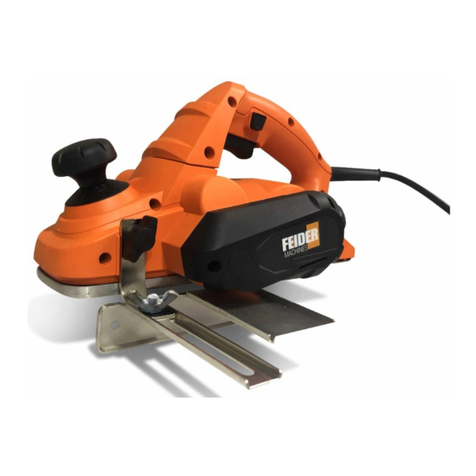
Feider Machines
Feider Machines FRB900 User manual
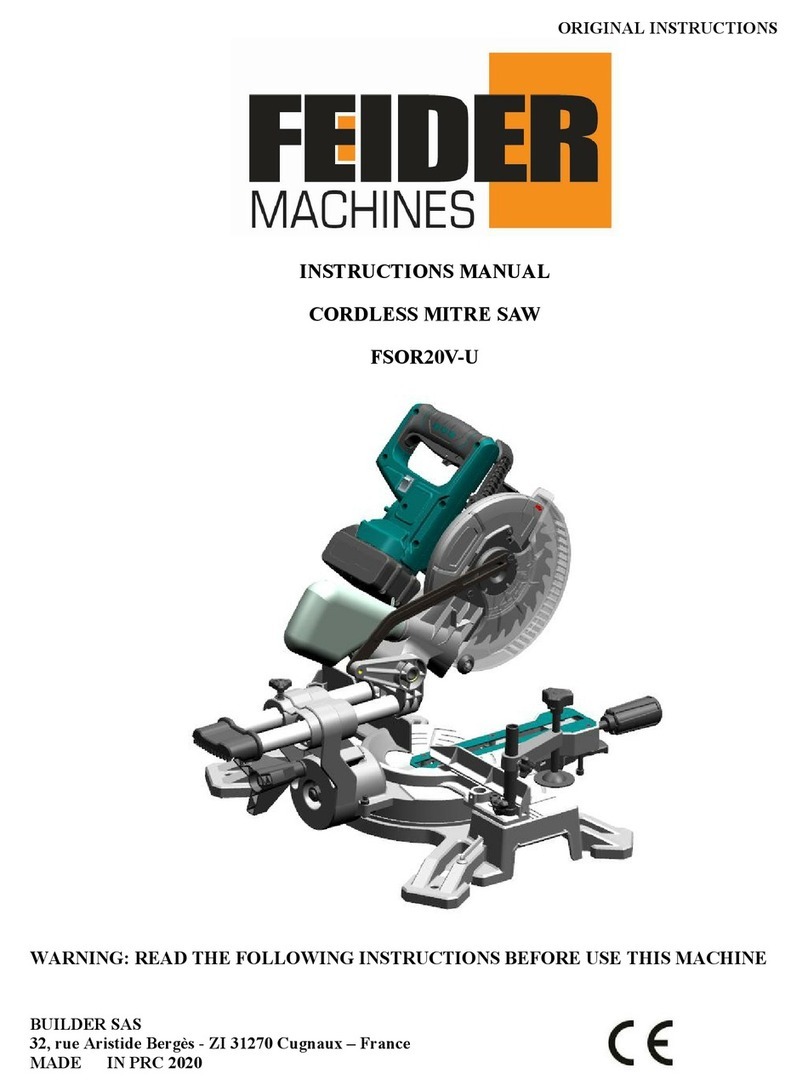
Feider Machines
Feider Machines FSOR20V-U User manual
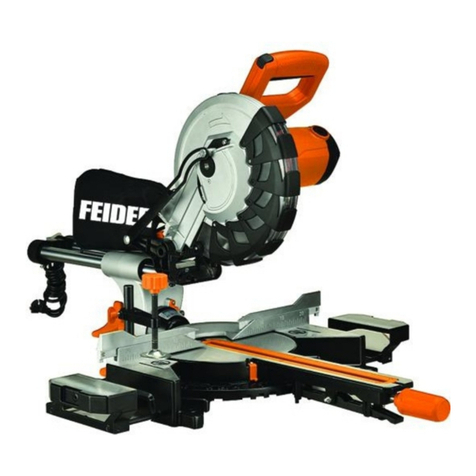
Feider Machines
Feider Machines FSO20254 User manual
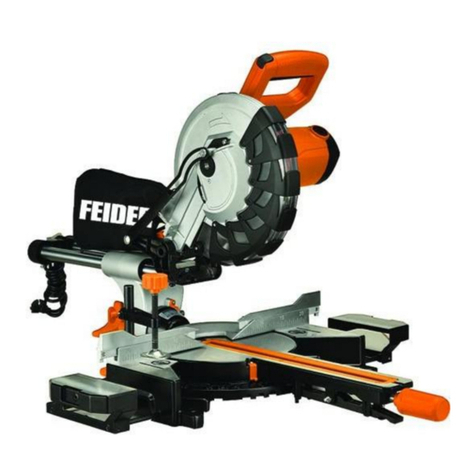
Feider Machines
Feider Machines FSOR20255 User manual

Feider Machines
Feider Machines FSP182A User manual
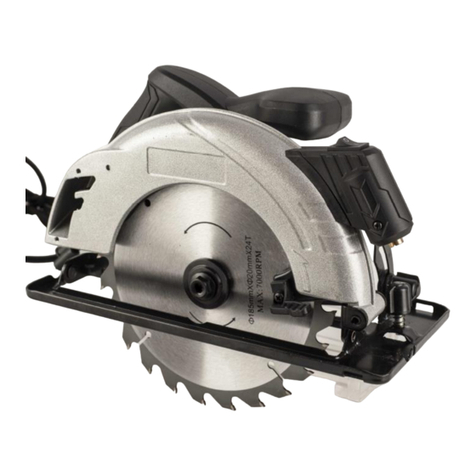
Feider Machines
Feider Machines FSC1485-B User manual
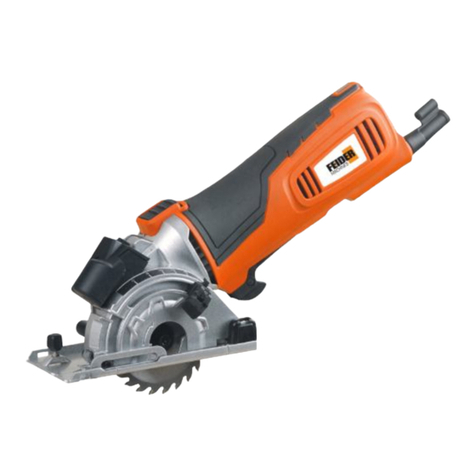
Feider Machines
Feider Machines FRX600 User manual
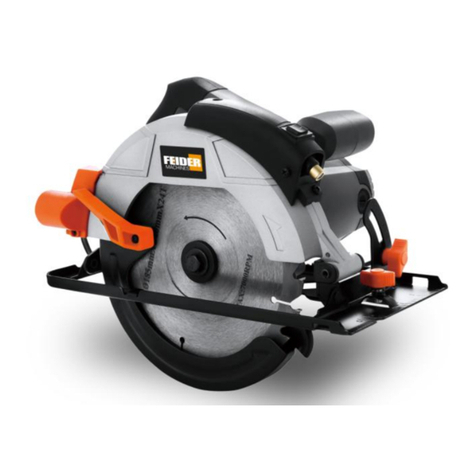
Feider Machines
Feider Machines FSC1485 User manual
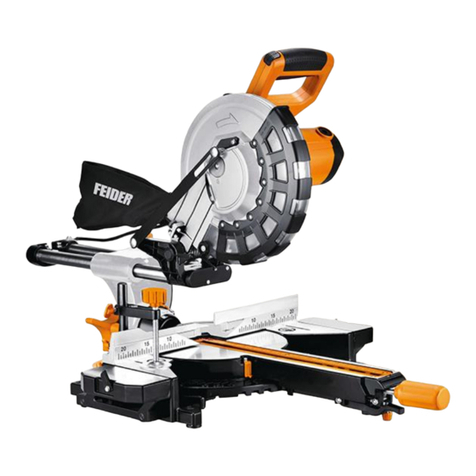
Feider Machines
Feider Machines FSOR17210 User manual
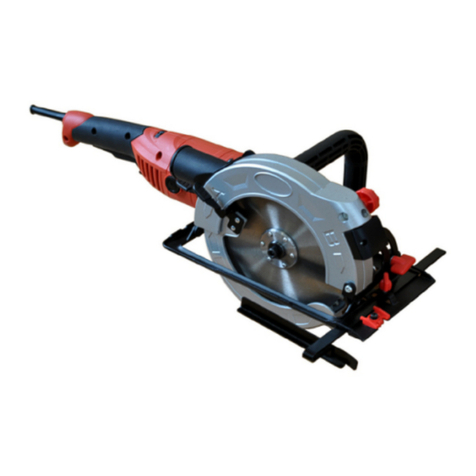
Feider Machines
Feider Machines FDL185 User manual
